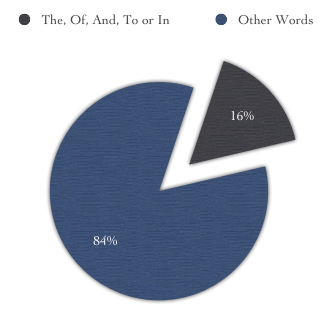In a recent writeup, BBC News covers a study by Lancaster University’s Professor Tony McEnery. It was also covered by Ars Technica, who put some attention grabbing spin on it by titling their article “Are iPods shrinking the British vocabulary?”
What the quoted study claims is that an excessive focus on technology is turning teenagers into passive listeners without ability to express themselves in spoken language.
Playing With Wire are today publishing an even more shocking study: both BBC News and Ars Technica are going down the same path as these teenagers. A word analysis of the BBC News article cited above reveals that a full 16% of the words in the article are common words such as ‘of’ and ‘in’.

Break-down of the words used in the BBC article. The most common words are used 68 times in an article of only 419 words.
The Ars Technica article also fails to impress in the vocabulary department. 54 of the 301 words in the article are extremely common and simple words. Just like in the BBC News article, the word ‘of’ is used to express a large part of the content.

Break-down of the words used in the Ars Technica article. Very common words are used 54 times in this short 301 word article.
Our analysis here at Playing With Wire indicates that since both the Ars Technica and the BBC News articles are published online, there is an excessive reliance on technology. An almost machine like approach to creating articles results in this bleak lack of imaginative word usage.
We absolutely do not think unification of the English language occurs online to reach the widest possible audience. In fact this ubiquitous unsophisticated locution employment has us flabbergasted. It’s stupefying.
Author: Alexander Ljungberg Tags: analysis







 Plug This
Plug This